Lysine requirements
Reevaluation of Amino Acid Requirements for Laying Hens. Part 2: Lysine Requeriment
Published: July 17, 2012
By: Philippe Joly (ISA-Hendrix Genetics)
Abstract
The results of 10 experiments realized from 1980 have been used to define more precisely the requirement of Lysine. Results show that the daily requirement for Lysine is related to the bird´s productivity. If the requirement is expressed in mg per gramme of egg mass produced, the requirement appears independent of the daily egg mass that is produced. From this analysis, we conclude that the economical Lysine requirement is estimated to be 15.00 mg for total or 13.34 mg for digestible Lysine per gramme of egg mass produced. The coefficient of variation obtained for this estimation is 8 %.
1. Introduction
Diet formulation and the reduction in dietary protein levels, considered essential for the achievement of economic goals and to protect the environment, necessitate a better understanding of amino acid requirements. The concept of ideal protein for layers is limited by our understanding of the «requirements».
The determination of a daily Lysine requirement has been attempted by many researchers. The results obtained were dependant on the productivity of the birds.
Just as for other species, genetic progress has a considerable influence on dietary amino acid concentrations. Over the last 30 years, production to a constant age has increased by more than 30 %, while feed consumption has been reduced by about 10 %. An important consequence of this genetic progress has been a change in the daily amino acid requirements.
It has also called into question the practice of phase feeding since productivity remains high over longer and longer periods. The best flocks nowadays have daily egg outputs of over 58g of egg mass up to 60 weeks of age and the best birds in a flock produce one egg every day until 80 weeks.
As a consequence, the recommendations for daily requirements (Table 1) are very variable since they do not take into account the evolution of the bird´s productivity.
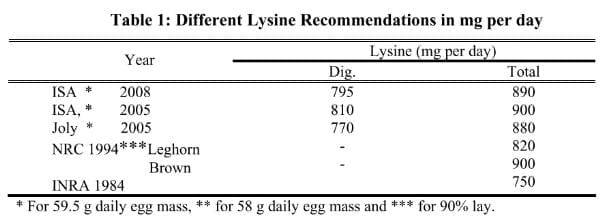
The requirement for Lysine has been studied by Zollitsch et al (1996) in 2 experiments. Their estimation of the requirement is 14.07 mg of digestible Lysine per gramme of egg mass in the first experiment and 12.07 mg of digestible Lysine in the second experiment. This represents a difference of around 15 % between both values and allows concluding that we cannot define a requirement with only 1 experiment.
A large variation has been also observed in the results involving 2 strains in the experiment of Goulard (1996) and in the experiment of Moraes et al, (2007). A review of all the research carried out on the Lysine requirement enables us to specify more precisely the requirements in mg per gramme of egg produced and to define the requirement in Lysine. This method permits us to keep abreast of genetic changes while limiting protein wastage and to allow the comparison of results from different authors irrespective of the level of production obtained.
2. Materials and Methods
10 experiments conducted mainly after 1995 have been used to define the requirement in Lysine. The objective was to define a requirement expressed in mg per gramme of egg mass, consequently we use the experiment given the result during a limited period of production which is during the peak of production.
Moraes et al, (2007) have studied the digestible requirement of white and brown birds from 34 – 50 weeks of age. The protein level was low (15.2 %) but the experimental diet were supplemented in Methionine, Isoleucine, Tryptophan and Threonine and without other limiting factors in my point of view. They found a daily digestible Lysine requirement using regression analysis of 893 mg for white birds and 804 mg for brown birds. The productivity was around 57g of egg mass per day over the period.
Moraes et al, (2007) have studied the digestible requirement of white and brown birds from 34 – 50 weeks of age. The protein level was low (15.2 %) but the experimental diet were supplemented in Methionine, Isoleucine, Tryptophan and Threonine and without other limiting factors in my point of view. They found a daily digestible Lysine requirement using regression analysis of 893 mg for white birds and 804 mg for brown birds. The productivity was around 57g of egg mass per day over the period.
Filho et al, (2006) have studied the ratio of Methionine+Cystine:Lysine. We have used the experimental diets having a M+C value of 0.70 or 0.71% for 3 levels of digestible Lysine, 0.718, 0.77 and 0.84 %. The authors have estimated the requirement to be 0.92% for total Lysine which represents a daily intake of 909 mg of digestible or 996 mg of total lysine for a daily egg mass produced of 61,28g. Martinez et al, (2005), have found a requirement in digestible Lysine at 0.728% or 655 mg calculated by a quadratic model. The egg mass produced during their experimental period of 10 weeks was 47 g, giving a requirement at 13.53 mg of dig. Lysine.
Balnave and Robinson, (2000) have tried to study the Lysine requirement with 5 different levels. They concluded that "the higher dietary Lysine concentrations were not reflected in significant responses in production suggesting that the lowest daily intake of 938 mg/day (total Lysine) was sufficient to satisfy the requirement of hens producing 53 g of egg mass daily". But they have expressed the result for the period of 19 to 61 weeks. Consequently we cannot determine a requirement expressed in mg per gramme of egg mass. But they said "the peak rates of lay varied between 94 and 99%". We can conclude that the requirement is lower than 938 mg per day for a production of around of (remove of) 59 g of egg mass per day due to the fact that the average egg weight was around 60 g. This corresponds at around 59- 60 g of egg mass produced at peak of production. One possible conclusion could be "the requirement in total lysine is lower than 15.8 mg (938/59.5) per gramme of egg mass". However, the coefficient of variation of the analysis for the lysine level was very high (10%). The result of this experiment is difficult to use.
In the Goulard´s experiments (1996), the values are the results of an average consumption and an average production calculated for the period of 21 to 37 weeks. In his thesis, results are expressed by periods of 4 weeks; consequently, we have given the results obtained for the 25-37 week period. The poor productivity of the layers, with a peak at around 81 % for the white birds and at 88 % for the brown could be related to a low protein level (14,8 %) together with other limiting factors. Total Methionine level was 0.36 %, total Tryptophan level 0,160 % and total Isoleucine level could be estimated at 0.60 %. For this reason, it is difficult to define a precise requirement in mg per gramme of egg mass or a daily requirement. Taking in account the egg mass and FCR, Goulard found a requirement in digestible lysine expressed in percentage at 0,710% for white layer and 0,691% for brown layer for a daily egg mass of 46 and 51g, corresponding for this author to a daily requirement of 705 and 722 mg of dig. Lysine.
Schutte (1998) in an experiment made on leghorns over a period of 12 weeks (24-36 weeks) has estimated the requirement for total lysine at 900 mg per day for a production of 57 g of egg mass per day. The Lysine digestibility could be estimated at 0.89, giving a requirement at 801 mg of dig. Lysine for 57g of egg mass.
Zollitsch et al (1996), tried to define the requirement for Lysine in 2 experiments. Their estimation of the digestible requirement is 14.07 mg of digestible Lysine per gramme of egg mass in the first experiment and 12.07 mg of digestible Lysine in the second experiment. This represents a difference of around 15 % between both values and allows us to conclude that we cannot define a requirement with only 1 experiment.
An old experiment made by Van Werden and Schutte (1980) shows that an experiment made 28 years ago can be used to define a requirement if we used the experimental data on the 39 – 50 week period.
Balnave and Robinson, (2000) have tried to study the Lysine requirement with 5 different levels. They concluded that "the higher dietary Lysine concentrations were not reflected in significant responses in production suggesting that the lowest daily intake of 938 mg/day (total Lysine) was sufficient to satisfy the requirement of hens producing 53 g of egg mass daily". But they have expressed the result for the period of 19 to 61 weeks. Consequently we cannot determine a requirement expressed in mg per gramme of egg mass. But they said "the peak rates of lay varied between 94 and 99%". We can conclude that the requirement is lower than 938 mg per day for a production of around of (remove of) 59 g of egg mass per day due to the fact that the average egg weight was around 60 g. This corresponds at around 59- 60 g of egg mass produced at peak of production. One possible conclusion could be "the requirement in total lysine is lower than 15.8 mg (938/59.5) per gramme of egg mass". However, the coefficient of variation of the analysis for the lysine level was very high (10%). The result of this experiment is difficult to use.
In the Goulard´s experiments (1996), the values are the results of an average consumption and an average production calculated for the period of 21 to 37 weeks. In his thesis, results are expressed by periods of 4 weeks; consequently, we have given the results obtained for the 25-37 week period. The poor productivity of the layers, with a peak at around 81 % for the white birds and at 88 % for the brown could be related to a low protein level (14,8 %) together with other limiting factors. Total Methionine level was 0.36 %, total Tryptophan level 0,160 % and total Isoleucine level could be estimated at 0.60 %. For this reason, it is difficult to define a precise requirement in mg per gramme of egg mass or a daily requirement. Taking in account the egg mass and FCR, Goulard found a requirement in digestible lysine expressed in percentage at 0,710% for white layer and 0,691% for brown layer for a daily egg mass of 46 and 51g, corresponding for this author to a daily requirement of 705 and 722 mg of dig. Lysine.
Schutte (1998) in an experiment made on leghorns over a period of 12 weeks (24-36 weeks) has estimated the requirement for total lysine at 900 mg per day for a production of 57 g of egg mass per day. The Lysine digestibility could be estimated at 0.89, giving a requirement at 801 mg of dig. Lysine for 57g of egg mass.
Zollitsch et al (1996), tried to define the requirement for Lysine in 2 experiments. Their estimation of the digestible requirement is 14.07 mg of digestible Lysine per gramme of egg mass in the first experiment and 12.07 mg of digestible Lysine in the second experiment. This represents a difference of around 15 % between both values and allows us to conclude that we cannot define a requirement with only 1 experiment.
An old experiment made by Van Werden and Schutte (1980) shows that an experiment made 28 years ago can be used to define a requirement if we used the experimental data on the 39 – 50 week period.
The conclusion of each researcher has been used to define a requirement in mg per gramme of egg mass produced. Each value obtained has been expressed as mg of amino acid per gramme of egg produced.
Some of experiments are based on values in amino acids analysed for the total Lysine value. To express the results in digestible values, we have determined the digestible Lysine coefficient according to the European Amino Acid Table (WPSA, 1992) for the Lysine content, and the INRA Raw Materials Table (2002) for the digestible value. In the case of Zollitsch´s experiment, the total amino acid values have been recalculated from the feed formula.
Some of experiments are based on values in amino acids analysed for the total Lysine value. To express the results in digestible values, we have determined the digestible Lysine coefficient according to the European Amino Acid Table (WPSA, 1992) for the Lysine content, and the INRA Raw Materials Table (2002) for the digestible value. In the case of Zollitsch´s experiment, the total amino acid values have been recalculated from the feed formula.
Most of studies have been conducted with a basal diet having a low lysine level. Supplementation with industrial lysine leads to an underestimation of the requirement expressed in total Lysine. To reduce this factor of variation in our analysis, we have expressed all results as digestible values.
The effect of Lysine on production cost has been studied considering that the feed during the laying period represents about 60% of the cost of production. We consider also that the higher egg mass produced reduces all the other fixed expenses; The impact could be estimated at 40% of the cost of production. This, without including the Lysine supplementation cost.
We have established the cost of production in each experiment for each Lysine level according to the following formula:
We have established the cost of production in each experiment for each Lysine level according to the following formula:
Production Cost of the diet (in %) = 60*EMopt/EMlevel + 40*FCRlevel/FCRopt +/- Lysine cost
With
- EMopt: daily egg mass obtained with the optimal diet
- EMdiet: daily egg mass obtained with the different level of Lysine studied
- FCRopt: FCR obtained with the optimal diet
- FCRdiet: FCR obtained with the different level of Lysine studied
- Lysine cost: 12 times the feed cost per kg*0.6= 0.0072, because the feed represents around 60% of the cost of production and the cost of 1 kg of Lysine is around 12 times the feed cost. By example, 100 mg of lysine added increases the feed cost by 1.2 % and consequently the cost of production by 0.72 %.
3. Results obtained by each researcher
The effect of each Lysine level on the productivity, on the cost of production obtained by each author is given in the Table A in the appendix. These results have been expressed also in percentage on the requirement based on the cost of production (Table B in the appendix). The Tables B and 2 are in fact a summary of the author´s results.
The conclusion of each researcher is synthesised in the Table 2, giving the conclusion of their experiment. We took the conclusion of each researcher concerning their estimated Lysine requirement .Some researchers gave their conclusion in total Lysine. According to the digestible value calculated from the INRA´s raw material table we have expressed their result in digestible value. In the Van Werden´s experiment we took the data of the 39-50 weeks period. The experiment of Balnave has not been taken into account because the optimal result was obtained with the lowest value.
The conclusion of each researcher is synthesised in the Table 2, giving the conclusion of their experiment. We took the conclusion of each researcher concerning their estimated Lysine requirement .Some researchers gave their conclusion in total Lysine. According to the digestible value calculated from the INRA´s raw material table we have expressed their result in digestible value. In the Van Werden´s experiment we took the data of the 39-50 weeks period. The experiment of Balnave has not been taken into account because the optimal result was obtained with the lowest value.
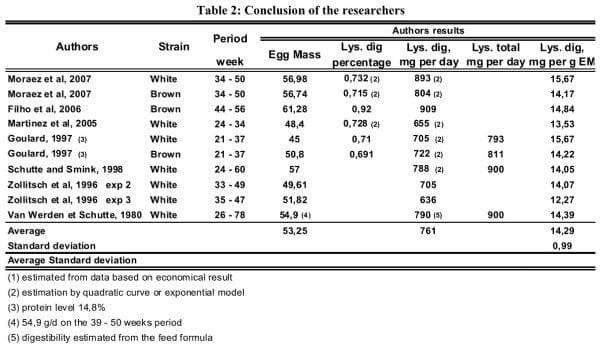
The regression between the digestible Lysine requirement and the egg mass produced per day coming from these data is given in the Figure 1.
Figure 1: Correlation between the Lysine requirement and the egg mass produced
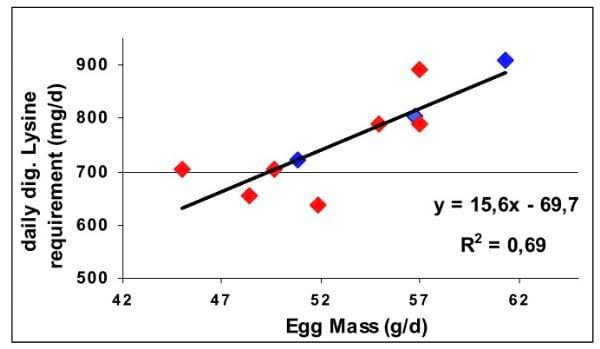
As observed in a previous study made on Methionine requirement (Joly, 2007), there is strong correlation between the requirement and the productivity. For this reason, we need to define a requirement for a given productivity and we need to express the requirement in mg per gramme of egg mass produced. The result of the regression gives a requirement of around 15 mg of digestible Lysine to produce 1g of egg mass.
If we express the conclusion of each author according to the productivity that they have observed, we are able to define a more precise requirement which is independent of the productivity (see Fig.2). With a coefficient of correlation of 0.01, we conclude that we need to express the requirement in mg per gramme of egg mass. Similar result has been obtained in our study on Methionine (Joly, 2007).
This result establishes clearly the necessity to express a requirement in amino acids in mg per gram of egg mass produced.
This result establishes clearly the necessity to express a requirement in amino acids in mg per gram of egg mass produced.
Points in blue in the Figure 2 & 3 represent the result obtained with Brown Birds. It seems that there is no difference between Brown birds and Leghorns for their requirement expressed in mg/g of Egg Mass produced
Figure 2: Correlation between the dig. Lysine requirement expressed in mg per g of egg mass and the egg Mass produced
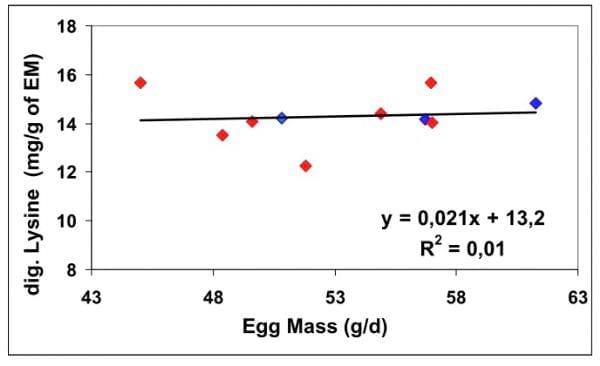
4. Lysine Requirement
Results
The average of the estimated requirement in digestible Lysine obtained by each researcher (Table 2) gives a requirement expressed in mg per gramme of egg mass:
Dig. Lysine:14.29mg (St. dev.: 0.99)
This value is the result in some experiments of an estimation based of a quadratic or exponential model to define the requirement as used by Moraez et al (2007), Martinez et al ( 200 5) , Goulard (1 997 ) and Schutte et Smin k (1998 ). Generally this method in creases the requirement and doesn´t take in account the feed cost.
Based of the result of each authors (Table B in annex) we have recalculated and expressed the requirement given the lowest cost of production;
Performances and cost of production obtained by each author are given in Table A and B in appendix. The cost of production has been calculated according the formula given in the ´materials and methods´ chapter.
Based of the result of each authors (Table B in annex) we have recalculated and expressed the requirement given the lowest cost of production;
Performances and cost of production obtained by each author are given in Table A and B in appendix. The cost of production has been calculated according the formula given in the ´materials and methods´ chapter.
Based on technical data and econo mical results (Table 3), the digestible requirement per gramme egg mass produced can be estimated at:
Table 3: Comparison between results based on the cost of production and the conclusion of researchers
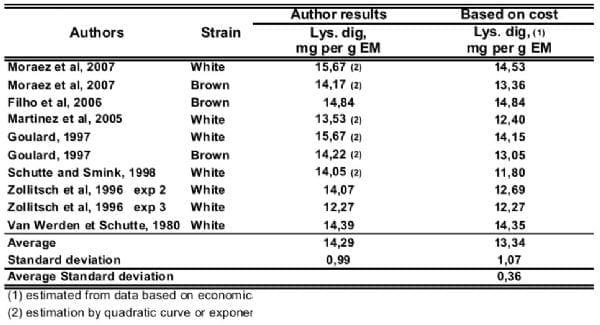
The coefficient of variation obtain ed for the average requiremen t is 2 .5 %.
Effect of a Lysine deficiency on performances
All experimental data, given in Table 3 , has been used to establish the effect of a Lysine deficiency on performances. The following figures give the effect on th e cost of production, FCR, Egg Mass, Egg Weight, Feed Consumption and Percentage of lay.
Figure 3: Relation between the cost of production and the Lysine level.
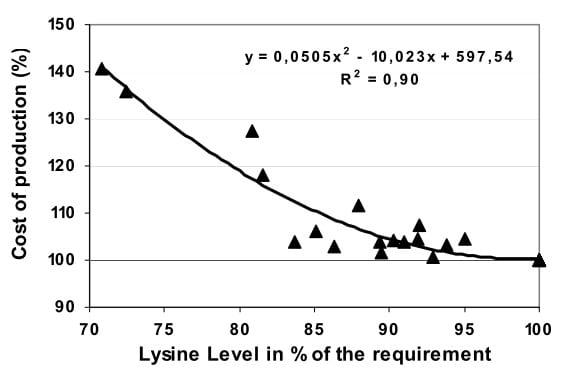
Figure 4: Relation between the FCR and Lysine level
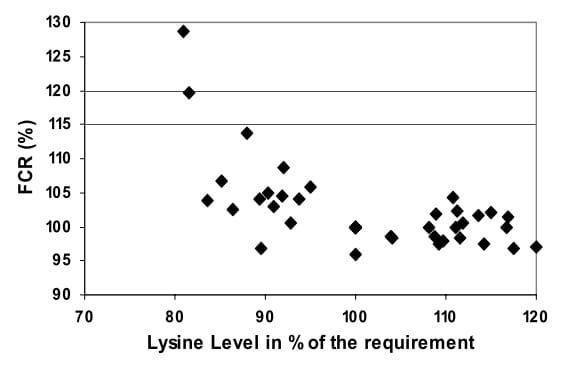
Figure 5: Relation between the daily Egg Mass produced and the Lysine level.
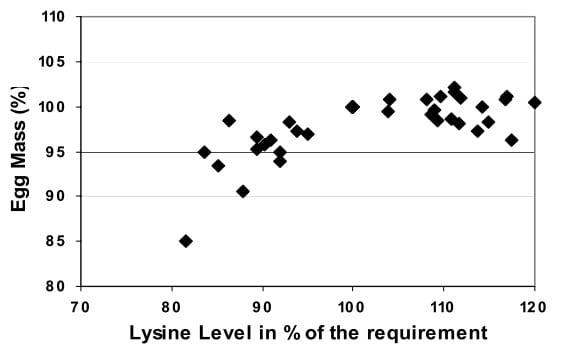
Figure 6: Relation between Egg Weight and the Lysine level.

Figure 7: Relation between Percentage of Lay and the Lysine level.
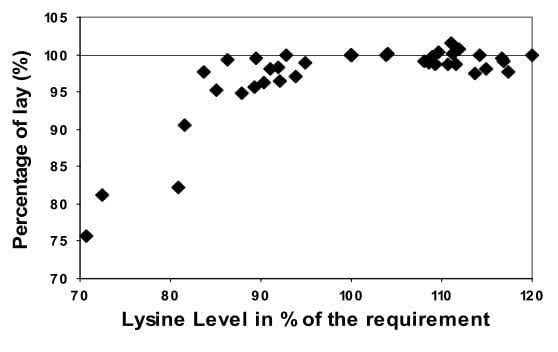
Figure 8: Relation between Feed Consumption and the Lysine level.
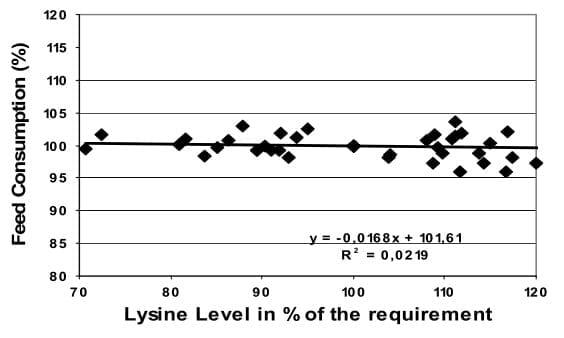
A Lysine deficiency affects all production parameters, egg weight, egg number and feed efficiency except for the feed consumption.
Egg weight and percentage of lay seem affected in the same proportion (Figure 9). Until a Lysine deficiency of 20 %, Egg Weight and Egg Number or Percentage of lay are affected in the same proportion. At high level of deficiency, production becomes the most affected parameter.
Figure 9: Relation between the Lysine level and the ratio between Egg Weight and Egg Number.
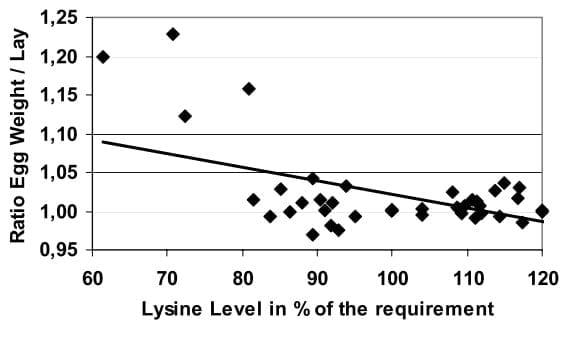
5. Conclusions
These results expressed the requirement based on the result of 10 experiments and do not account any safety margin to take in account the variability of raw materials.
Requirement per gramme of egg produced
Based on the result from this study and based on economical results it allows use to conclude that the estimated digestible requirement is:
Dig. Lysine: 13.34 mg
The estimation of the total Lysine value has been made by using the digestible coefficient expressed in the raw material table published by INRA (2002) for a standard corn-wheat- soya feed with a digestibility of 89.0%. (13.34:0.89)
Total Lysine: 15.00 mg
Requirement per Day
With a daily production at the peak of production fixed at 59.5g per day, the daily requirement could be estimated at:
Lysine (total): 895 mg
Dig. Lysine: 795 mg
These results are similar at those found in our previous review (Joly, 2002) estimated at 13.50 mg of digestible level per gramme of egg mass.
Requirement according to Feed Efficiency
Another way is to express the requirement in percentage of amino acids per kg of feed, according to the feed conversion ratio. The following table (Table 4) gives the percentage of Lysine in the feed according to the feed conversion during the peak production period.
Table 4: Lysine requirement according to the Feed Conversion Ratio observed during the peak of production

Requirement at start of lay
Due to a lower body weight and consequently a lower feed consumption, from 18 to 28 weeks, we advice to increase the amino acid levels by 6 % during this period to satisfy the bird´s requirement and to reduce the risk of a deficiency or the risk of an under-consumption (Joly, 2002).
References
Balnave, D. and D, Robinson, 2000. Amino Acid and Energy requirements of imported Brown Layer Strains. A report for the Rural Industries Research Development Corporation. RIRDC publication N°00/179
Gous, R.M., Griessel, M., and T.R. Morris, 1987. Effect of dietary energy concentration on the response of laying hens to amino acids. British Poultry Sci., - 28 : 427-436
Filho, J.J., Vilar da Silva, J.H., Lindolfo da Silva, E., Araujo, D de M., Gomes Ribeiro, M.L., and M. Ramalho de Lima, 2006. Efeitos da relaçao metionina + cystina:lisina sobre os desempenhos produtivo e economico e a qualida interna e externa dos ovos antes e apos 28 dias de armazenamento. R. Bras. Zootec., v.35,n.4, p.1735-1743, 2006 (supl.).
Goulart, C.C, 1997. Exigencia nutricional de lisina para poedeiras leves e semipesados. Teseapresentada à Universidade Federal de Viçosa. VICOSA – MINA GERAIS – BRASIL FEVEREIRO – UFV,1997.
INRA, 2002. Tables de composition et de valeur nutritive des matières premières destinées aux animaux d´élevage, INRA éditions,
ISA, 1996, ISABROWN Management Guide.
ISA, 2005, Layer Management Guide.
Joly, P., 2002. Estimation of the amino acids requirements of laying hens in relation to the genetic evolution. Technical Bulletin. ISA
Joly, P., 1995. An up date of the amino acids requirements of the laying hens. World´s Poultry Science Association. 10th European Symposium on Poultry Nutrition. Oct, 5-19th 1995. WPSA proceedings. Antalya-Turkey, p 294 -299
Joly, P., 1995. Réactualisation des besoins en Acides Aminés de la pondeuses, 1ères Journées de la Recherche Avicole.28,29,30 mars 1995. Angers. p. 1-8.
Joly,P., 2007. Reactualisation of the amino acid requirements for laying hens. Part 1: Methionine and cystine requirements updated in 2007 from 15 experiments. ISA-Technical document
Mc Donald, M.W, 1979. In Mc Donald, M.W. et T.R. Morris, 1985. Quantitative review of optimum amino acid intakes for young laying pullet. Br. poult.Sci,, 26 :253-264
Martinez, F.M, Diaz Cruz, A., Lecumberri, J. and E. Gonzalez, 2005. Necesidades de lysina y aminoacidos azufrados digestibles en gallinas Leghorn Blancas. Vet. Mex., 36 (2): 135-14.5
Moraes Sa, L., Rostagno, H.S., Teixeira Albino, L,F, and D´Agostini,P., 2007. Exigencia nutricional de lisina digestivel para galinhas poedeires no periodo de 34 ac 50 semanas de idade. R. Bras. Zootec. Vol. 36 n°6 1829-1836.
NRC, 1994. Nutrient requirements of poultry. Ninth Revised Edition. National Research Council.
Schutte, J.B.,and W. Smink, 1998. Requirement of laying hen for Apparent Fecal Digestible Lysine. Poultry Sci. 77: 697-701.
Uzu G. and Larbier M., 1985. Lysine Requirement of the laying hen. Archiv. Geflugelk., 49, 148 - 190
Gous, R.M., Griessel, M., and T.R. Morris, 1987. Effect of dietary energy concentration on the response of laying hens to amino acids. British Poultry Sci., - 28 : 427-436
Filho, J.J., Vilar da Silva, J.H., Lindolfo da Silva, E., Araujo, D de M., Gomes Ribeiro, M.L., and M. Ramalho de Lima, 2006. Efeitos da relaçao metionina + cystina:lisina sobre os desempenhos produtivo e economico e a qualida interna e externa dos ovos antes e apos 28 dias de armazenamento. R. Bras. Zootec., v.35,n.4, p.1735-1743, 2006 (supl.).
Goulart, C.C, 1997. Exigencia nutricional de lisina para poedeiras leves e semipesados. Teseapresentada à Universidade Federal de Viçosa. VICOSA – MINA GERAIS – BRASIL FEVEREIRO – UFV,1997.
INRA, 2002. Tables de composition et de valeur nutritive des matières premières destinées aux animaux d´élevage, INRA éditions,
ISA, 1996, ISABROWN Management Guide.
ISA, 2005, Layer Management Guide.
Joly, P., 2002. Estimation of the amino acids requirements of laying hens in relation to the genetic evolution. Technical Bulletin. ISA
Joly, P., 1995. An up date of the amino acids requirements of the laying hens. World´s Poultry Science Association. 10th European Symposium on Poultry Nutrition. Oct, 5-19th 1995. WPSA proceedings. Antalya-Turkey, p 294 -299
Joly, P., 1995. Réactualisation des besoins en Acides Aminés de la pondeuses, 1ères Journées de la Recherche Avicole.28,29,30 mars 1995. Angers. p. 1-8.
Joly,P., 2007. Reactualisation of the amino acid requirements for laying hens. Part 1: Methionine and cystine requirements updated in 2007 from 15 experiments. ISA-Technical document
Mc Donald, M.W, 1979. In Mc Donald, M.W. et T.R. Morris, 1985. Quantitative review of optimum amino acid intakes for young laying pullet. Br. poult.Sci,, 26 :253-264
Martinez, F.M, Diaz Cruz, A., Lecumberri, J. and E. Gonzalez, 2005. Necesidades de lysina y aminoacidos azufrados digestibles en gallinas Leghorn Blancas. Vet. Mex., 36 (2): 135-14.5
Moraes Sa, L., Rostagno, H.S., Teixeira Albino, L,F, and D´Agostini,P., 2007. Exigencia nutricional de lisina digestivel para galinhas poedeires no periodo de 34 ac 50 semanas de idade. R. Bras. Zootec. Vol. 36 n°6 1829-1836.
NRC, 1994. Nutrient requirements of poultry. Ninth Revised Edition. National Research Council.
Schutte, J.B.,and W. Smink, 1998. Requirement of laying hen for Apparent Fecal Digestible Lysine. Poultry Sci. 77: 697-701.
Uzu G. and Larbier M., 1985. Lysine Requirement of the laying hen. Archiv. Geflugelk., 49, 148 - 190
Van Weerden E.J. and Schutte J.B., 1980. Lysine Requirement of the laying hen. Archiv. Geflugelk, 44, 36 - 40
WPSA,1992. European Amino Acid tables. Working Group nr. 2 (nutrition) of the WPSA.
Zollitsch, W., Cao, Z., Peguri, A., and B. Zhang, 1996. Nutrient requirements of laying hens. International Symposium on nutritional requirements of Poultry and Swine. Editor H.S. Rostagno
Zollitsch, W., Cao, Z., Peguri, A., and B. Zhang, 1996. Nutrient requirements of laying hens. International Symposium on nutritional requirements of Poultry and Swine. Editor H.S. Rostagno
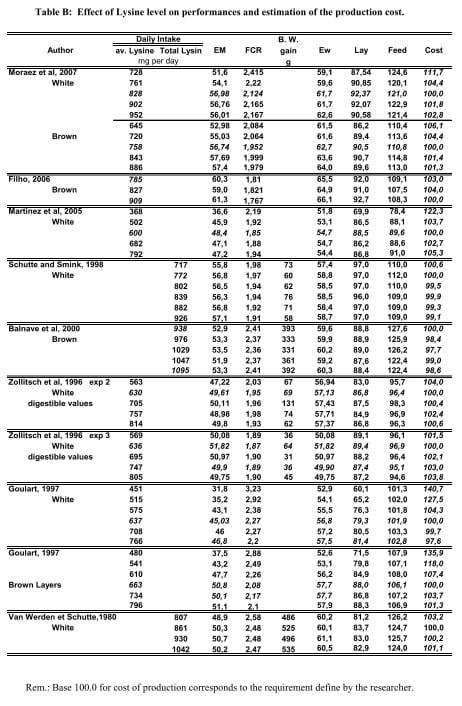
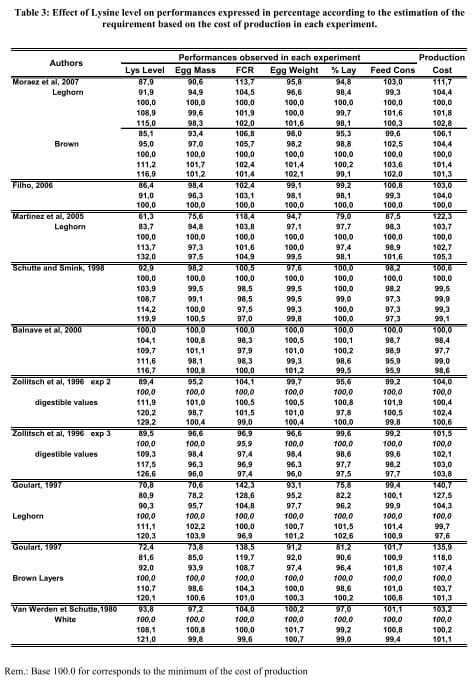
Related topics:
Authors:
Recommend
Comment
Share

Would you like to discuss another topic? Create a new post to engage with experts in the community.








.jpg&w=3840&q=75)